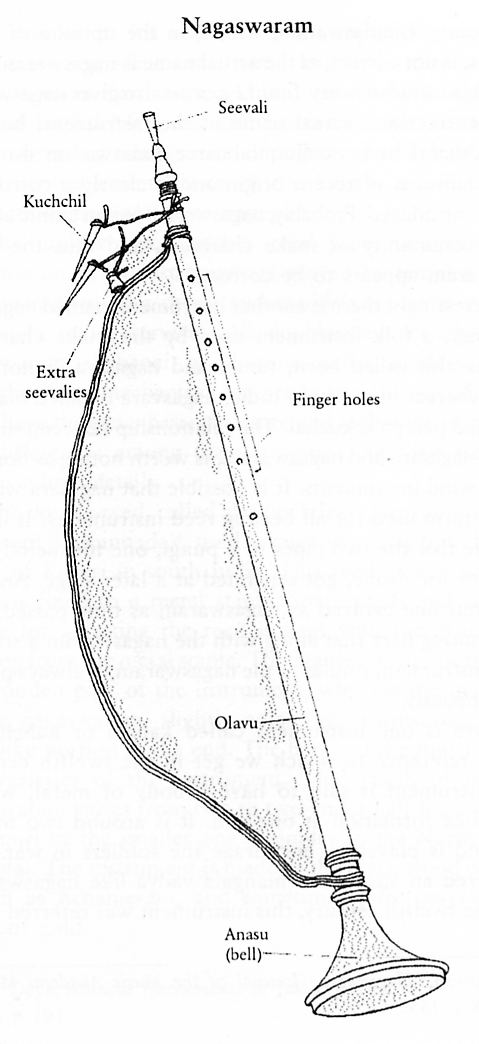Kleines Lexikon indischer Instumente
Der Text ist in gekürzter Form von Suneera Kasliwal, Classical Musical Instruments, Delhi 2001, entnommen.
Nageshwaram
The wind instrument known as nagaswaram, also called nayanam, has a unique place in the annals of the history of Carnatic music.
All double-reed aerophones - nagaswaram, shahanai, mukhveena, nafiri, sundari, etc. - have the same mechanism for producing the sound. All of them have the same basic structure and technique of playing. The differences among them lie mostly in. their sizes and certain minor details.
The double reed, called aku (in Telegu), seevali (in Tamil) and peepi (in Kannada) used in nagaswaram is found on the banks of Kaveri in south India. This reed, which acts as a valve, is fixed to a metal staple. Spare reeds and an ivory needle for adjusting the reed is kept with the instrument, hanging from the metal staple. This staple is thus inserted into the wooden pipe of the instrument, which is the main part of the nagaswaram, slightly enlarging downwards, with a horn like portion at the end. The bari and the timiri are the two varieties of the instrument. The length of the bari nagaswaram varies from two to two-and-a-half feet, whereas the timiri or the smaller one is similar to the North Indian shahanai. The instrument is made of the black wood of a tree known as Achameram, and sometimes fully covered with silver or gold.
There are seven playing holes and five auxiliary ones. These auxiliary holes, slightly tilted from the other seven holes, are called brahmswaram. They are used only to adjust the pitch. Out of the five holes plugging of one or two with wax can either raise or lower the basic pitch of the instrument. The other instrument, also called the sruti or ottu, played as an accompaniment to the main nagaswaram, keeps the drone or the basic key note of the main instrument. Although it appears to be similar in shape and construction, it is slightly longer than the nagaswaram. It consists of a wooden conical bore of about two-and-a-half feet in length and enlarges downwards with five or six holes at the farthest end, which are wholly or partially closed with wax to tune the drone to the key note of the main pipe. The drone note is produced continuously without a break by using a special method of blowing.
Nagaswaram, or any of its types, i.e. shahanai, mukhveena, etc., do not have keys for playing. The fingers of the player come into direct contact with the holes as is necessary for techniques like meend and gamaka of Indian classical music. The accompanying percussion instrument is called tavil in Tamil and dolu in Telegu. Talam, the large cymbals made of bell metal are also used to keep time with the nagaswaram.
Nagaswaram is closely identified with temples and other religious events. In the south, among the multitude of musical instruments the nagaswaram alone has earned the distinction of a mangal vadya, an instrument of auspiciousness. The music produced is believed to be auspicious and, therefore, it has been given a pride of place in temple rituals and social events. The instrumental ensembles, with nagaswaram being the principal instrument, are called peria melam or pedda melam. Other than the nagaswaram, instruments participating in this melam are generally two ottus (drone), tavil, talam and sometimes shankh. Almost every temple in south India, whether rich or poor, invariably has a periya melam in its establishment. The periya melam is also heard at weddings, royal processions and other festivities.
Like the flute, the species of reed pipes have also found their way from folk music into the sophisticated concert music. Though related to temples, nagaswaram has always held a relatively higher status than the other reed instruments. However, it was not considered a classical instrument till three or four decades ago. Artists like T.N. Rajaratnam Pillai and Karukurichi Arunachalam are to be credited for the present high status of nagaswaram on the Carnatic concert platforms.
Almost all the different shailies, subtle nuances of the ragas and different embellishments of Carnatic music swaras can be produced on the nagaswaram by fully or partially opening the finger holes, controlling the breath and working the lips, tongue and teeth upon the reed. The system of fingering adopted for the production of seven notes is the same as in the case of the flute. Half and quarter tones are a result of the synchronisation of the intelligent fingering and the adjustment of the pressure of the air blown into the pipe. Acquiring playing skills of nagaswaram is a laborious process involving long and arduous practice and dedication.
All nagaswaram players, both of Tamil Nadu and Andhra Pradesh, generally use the fingers of the left hand for stopping and closing the upper holes, the holes closer to the air blowing orifice and the fingers of the right hand for the lower ones. Sarangadeva's treatise Sangeet Ratnakara, which offers guidance on this subject also, in its passages on wind instruments, specifies that the left hand fingers are to be employed for the upper holes. But Chinna Moulana, one of the stalwart nagaswaram players of present times, has reversed the roles of the hands, perhaps not deliberately, but this has in no way handicapped Chinna Moulana's playing.
